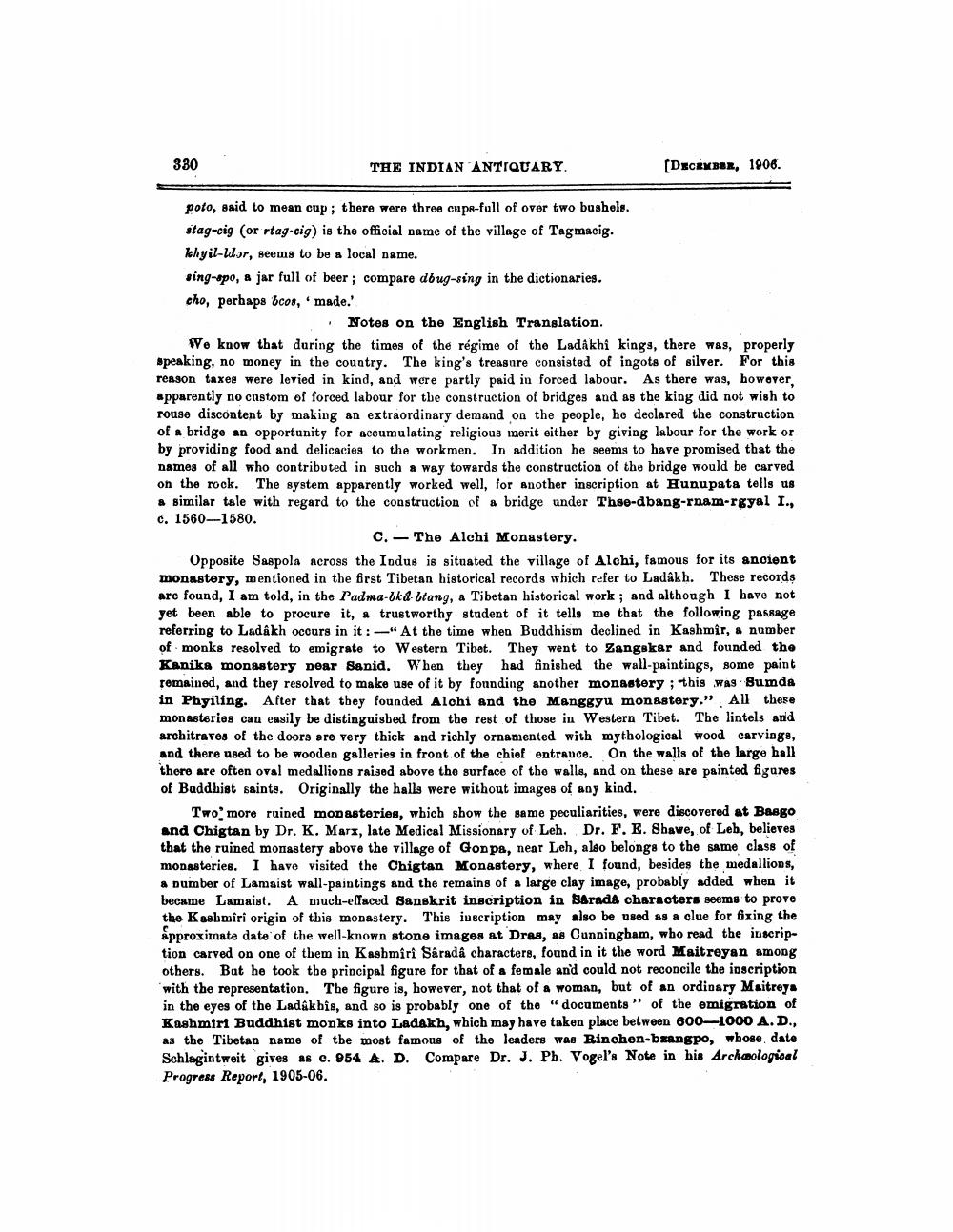________________
330
THE INDIAN ANTIQUARY.
[DECEMBER, 1906.
poto, said to mean cup; there were three cups-full of over two bushele. stag-cig (or rtag.cig) is the official name of the village of Tagmacig. Ichyil-Idor, seems to be a local name. sing-spo, a jar full of beer; compare dbug-sing in the dictionaries. cho, perhaps bcos, made.'
Notes on the English Translation. We know that during the times of the régime of the Ladakhi kings, there was, properly speaking, no money in the country. The king's treasure consisted of ingots of silver. For this reason taxes were levied in kind, and were partly paid in forced labour. As there was, however, apparently no custom of forced labour for tbe construction of bridges and as the king did not wish to rouge discontent by making an extraordinary demand on the people, he declared the construction of a bridge an opportunity for accumulating religious merit either by giving labour for the work or by providing food and delicacies to the workmen. In addition he seems to have promised that the names of all who contributed in such a way towards the construction of the bridge would be carved on the rock. The system apparently worked well, for another inscription at Hunupata tells us a similar tale with regard to the construction of a bridge under Thse-dbang-rnam-rgyal I., c. 1560--1580.
C. - The Alchi Monastery. Opposite Saspola across the Indus is situated the village of Alohi, famous for its ancient monastery, mentioned in the first Tibetan historical records which refer to Ladakh. These records are found, I am told, in the Padma-bkd btang, a Tibetan historical work; and although I have not yet been able to procure it, & trustworthy student of it tells me that the following passage referring to Ladakh occurs in it: --"At the time when Buddhism declined in Kashmir, a number of monks resolved to emigrate to Western Tibet. They went to Zangakar and founded the Kanika monastery near Sanid. When they had finished the wall-paintings, some paint remained, and they resolved to make use of it by founding another monastery ; this was Sumda in Phyiling. After that they founded Alohi and the Manggyu monastery." All these monasteries can easily be distinguisbed from the rest of those in Western Tibet. The lintels and architraves of the doors are very thick and richly ornamented with mythological wood carvings, and there used to be wooden galleries in front of the chief entrauce. On the walls of the large hell there are often oval medallions raised above the surface of the walls, and on these are painted figures of Buddhist saints. Originally the halls were without images of any kind.
Two more ruined monasteries, which show the same peculiarities, were discovered at Basgo and Chigtan by Dr. K. Marx, late Medical Missionary of Leh. Dr. F. E. Shawe, of Leb, believes that the ruined monastery above the village of Goppe, near Leh, also belongs to the same class of monasteries. I have visited the Chigtan Monastery, where I found, besides the medallions, a number of Lamaist wall-paintings and the remains of a large clay image, probably added when it became Lamaist. A much-effaced Sanskrit inscription in Sarada characters seems to prove the Kasbmiri origin of this monastery. This inscription may also be used as a clue for fixing the approximate date of the well-known stone images at Dras, as Cunningham, who read the inscription carved on one of them in Kasbmiri Sarada characters, found in it the word Maitreyan among others. Bat he took the principal figure for that of a female and could not reconcile the inscription with the representation. The figure is, however, not that of a woman, but of an ordinary Maitreya in the eyes of the Ladakbis, and so is probably one of the "documents" of the emigration of Kashmirt Buddhist monks into Ladakh, which may have taken place between 600—1000 A.D., as the Tibetan name of the most famous of the leaders was Rinchen-bxangpo, whose date Schlagintweit gives as e. 954 A. D. Compare Dr. J. Ph. Vogel's Note in his Archæological Progress Report, 1905-06.




